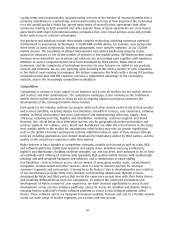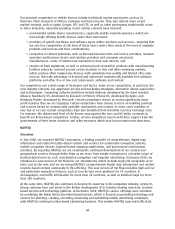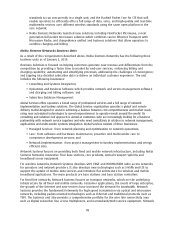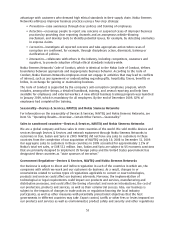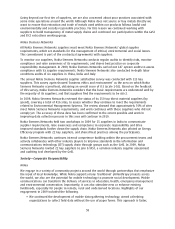Nokia 2009 Annual Report Download - page 53
Download and view the complete annual report
Please find page 53 of the 2009 Nokia annual report below. You can navigate through the pages in the report by either clicking on the pages listed below, or by using the keyword search tool below to find specific information within the annual report.Nokia Siemens Networks generally prefers to have multiple sources for its components, but it sources
some components from a single or a small number of selected suppliers. These business relationships
are stable and typically involve a high degree of cooperation in research and development, product
design and manufacturing to ensure optimal product interoperability.
Technology, Research and Development
The Chief Technology Office at Nokia Siemens Networks focuses on research, standardization,
intellectual property rights, innovation, R&D services and platform development. It cooperates with
universities, the IT industry, standardization and other industry cooperation bodies worldwide.
Nokia Siemens Networks research and development work focuses on wireless and wireline
communication solutions that enable communication services for people and businesses. These
include wireless connectivity solutions like GSM/EDGE, 3G/WCDMA, HSPA, TDLTE and LTE and wireline
connectivity solutions based on copper (ADSL, VDSL with Fiber to the curb, or FTTC, Fiber to the
building, or FTTB), and fiberbased next generation optical access, or NGOA.
In the transport and aggregation domain, carrier ethernet, IP routing, IP traffic analysis and multi
access mobility are among the key focus areas. Within the applications domain, research and
development focuses on service enabling, network valueadded services, identity management, and
subscriber and device profile data storage. It also focuses on peertopeer, or persontoperson
services, IP connectivity session control (IMS) & VoIP, network/service/subscriber/device management,
online and offline charging for post and prepaid subscribers.
Patents and Licenses
Nokia Siemens Networks seeks to safeguard its investments in technology through adequate
intellectual property rights, including patents, patent applications, design patents, trade secrets,
trademark registrations and copyrights. Nokia Siemens Networks owns a significant portfolio
comprising IPR that was transferred from its parent companies at formation and IPR filed since its
start of operations. Nokia Siemens Networks is a world leader in the research and development of
wireless technologies, as well as transport and broadband technologies, and it has robust patent
portfolios in a broad range of technology areas. The IPR portfolio includes standardsrelated essential
patents and patent applications that have been declared by Nokia and Siemens. Nokia Siemens
Networks has declared its own essential patents and patent applications based on evaluation of
pending cases with respect to standards. Nokia Siemens Networks receives and pays certain patent
license royalties based on existing agreements with telecommunication vendors.
Competition
In 2009, the competitive environment in the telecommunications infrastructure market was
characterized by the continued rise of low cost vendors from China, namely Huawei and ZTE. These
Chinese vendors have challenged the three major European vendors, AlcatelLucent, Ericsson and
Nokia Siemens Networks, that emerged following the major industry consolidation that took place in
2007. Huawei, which has been a major competitor already prior to 2009, strengthened its global
position during the course of the year to become the fourth major participant in the global
equipment and services infrastructure market in 2009. The second Chinese vendor, ZTE, has also
become a more visible albeit more distant, competitor during 2009, particularly in the fixed line
market, but remained some distance behind its local rival and the three European companies.
The second major development in 2009 was the breakup of Nortel, which entered bankruptcy
protection in January 2009. Many parts of the business have been sold in bankruptcy court, including
the wireless carrier unit, Metro Ethernet Networks and GSM business.
In addition to the major infrastructure providers, our principal competitors in selected areas of the
market also include Cisco, Motorola and NEC.
51




